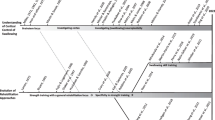Abstract
Purpose
To describe the primary effects of electromyographic biofeedback therapy on swallowing via a systematic review.
Methods
A blind search was carried out by two researchers in the PubMed and Bireme platforms and in the Medline, Lilacs, SciELO, PsycINFO, CINAHL, and Web of Science databases, and the journal articles identified therein were evaluated for inclusion in the study. Original articles associated with the theme were selected with no population-, region-, or language-associated limits. A protocol was created for this study with the following points: author, year, place, number and characteristics of participants, activities evaluated, instruments used, and main results. The PEDro scale was used to analyze the quality of the studies.
Results
Among the 686 articles identified in the combined searches, 566 were duplicates. A total of 65 articles were discarded after the title and abstract were read, and a further 29 articles were discarded after the full text was read, yielding a total of six articles for inclusion. In summary, the results lead us to believe that positive effects on the laryngeal lifting capacity, improved swallowing functions, and increased excursion and maximal elevation of the hyoid bone, may be directly related to this method of therapy.
Conclusions
Adjunctive therapeutic protocols with biofeedback electromyography exert positive effects on swallowing function.

Similar content being viewed by others
Data availability
Data sharing is not applicable to this article as no new data were created or analyzed in this study.
References
World Health Organization (2004) Changing history. World Health Organization. http://apps.who.int/iris/bitstream/handle/10665/40492/9241540052_eng_v2_p1.pdf?sequence=3-2560k. Accessed 07 Apr 2018
Smithard DG, O’Neill PA, Park C et al (1996) Complications and outcome after acute stroke: does dysphagia matter. Stroke 27:1200–1204
Mann G, Hankey GJ, Cameron D (2000) Swallowing disorders following acute stroke: prevalence and diagnostic accuracy. Cerebrovasc Dis 10:380–386
Chai J, Chu FCS, Chow TW et al (2008) Prevalence of malnutrition and its risk factors in stroke patients residing in an infirmary. Singapore Med J 49:290–296
Altman KW, Yu G, Schaefer SD (2010) Consequence of dysphagia in the hospitalized patient: impact on prognosis and hospital resources. Arch Otolaryngol Head Neck Surg 136:784–789
Logemann JA (1991) Approaches to management of disordered swallowing. Baillieres Clin Gastroenterol 5:269–280
Shaw GY, Sechtem PR, Searl J et al (2007) Transcutaneous neuromuscular electrical stimulation (VitalStim) curative therapy for severe dysphagia: myth or reality. Ann Otol Rhinol Laryngol 116:36–44
Crary MA (1995) A direct intervention program for chronic neurogenic dysphagia secondary to brainstem stroke. Dysphagia 10:6–18
Huckabee M, Cannito M (1999) Outcomes of swallowing rehabilitation in chronic brainstem dysphagia: a retrospective evaluation. Dysphagia 14:93–109
Foley N, Teasell R, Salter K et al (2008) Dysphagia treatment post stroke: a systematic review of randomised controlled trials. Age Ageing 37:258–264
Martino R, Mcculloch T (2016) Therapeutic intervention in oropharyngeal dysphagia. Nat Publ Gr 13(11):665–679
Van Borsel J, Sierens S, Pereira MMB (2007) Using delayed auditory feedback in the treatment of stuttering: evidence to consider. PróFono 19(3):323–332
Crary M, Carnaby MG, Groher M et al (2004) Functional benefits of dysphagia therapy using adjunctive sEMG biofeedback. Dysphagia 19(3):160–164
Robson B (2016) Studies in using a universal exchange and inference language for evidence-based medicine. Semiautomated learning and reasoning for PICO methodology, systematic review, and environmental epidemiology. Comput Biol Med 1:299–323
Maher CG, Sherrington C, Herbert RD et al (2003) Reliability of the PEDro scale for rating quality of randomized controlled trials. Phys Ther 83:713–721
Tang Y, Lin X, Lin XJ et al (2017) Therapeutic efficacy of neuromuscular electrical stimulation and electromyographic biofeedback on Alzheimerʼs disease patients with dysphagia. Medicine (Baltimore) 96(36):e8008
Azola AM, Sunday KL, Humbert IA (2017) Kinematic visual biofeedback improves accuracy of learning a swallowing maneuver and accuracy of clinician cues during training. Dysphagia 32(1):115–122
Bogaardt HCA, Grolman W, Fokkens WJ (2009) The use of biofeedback in the treatment of chronic dysphagia in stroke patients. Folia Phoniatr Logop 61(4):200–205
Athukorala RP, Jones RD, Sella O et al (2014) Skill training for swallowing rehabilitation in patients with Parkinson’s disease. Arch Phys Med Rehabil 95(7):1374–1382
McCullough GH, Kamarunas E, Mann GC et al (2012) Effects of mendelsohn maneuver on measures of swallowing duration post stroke. Top Stroke Rehabil 19(3):234–243
Ding R, Larson CR, Logemann JA et al (2002) Surface electromyographic and electroglottographic studies in normal subjects under two swallow conditions: normal and during the Mendelsohn maneuver. Dysphagia 17(1):1–12
Boyle R, Hay-Smith EJ, Cody JD et al (2012) Pelvic floor muscle training for prevention and treatment of urinary and faecal incontinence in antenatal and postnatal women. Cochrane Database Syst Rev 17(10):CD007471
Dumoulin C, Hay-Smith EJ, Mac Habée-Séguin G (2014) Pelvic floor muscle training versus no treatment, or inactive control treatments, for urinary incontinence in women. Cochrane Database Syst Rev 14(5):CD005654
Robbins J, Butler SG, Daniels SK, Lazarus CL, Mccabe D (2008) Rehabilitation: translating principles. Hear Res 51:276–300
Manor Y, Mootanah R, Freud D, Giladi N, Cohen JT (2013) Video-assisted swallowing therapy for patients with Parkinson’s disease. Park Relat Disord 19(2):207–211
Huckabee M, Macrae P (2014) Rethinking rehab: skill-based training for swallowing impairment. SIG 13:46–53
Burdea GC (2003) Virtual rehabilitation—benefits and challenges. Methods Inf Med 42:519–523
Barzilay O, Wolf A (2013) Adaptive rehabilitation games. J Electromyogr Kinesiol 23(1):182–189
Funding
The study received no funding.
Author information
Authors and Affiliations
Corresponding author
Ethics declarations
Conflict of interest
The authors report no conflicts of interest.
Ethical approval and informed consent
This article does not contain any studies with human participants or animals performed by any of the authors.
Additional information
Publisher’s Note
Springer Nature remains neutral with regard to jurisdictional claims in published maps and institutional affiliations.
Rights and permissions
About this article
Cite this article
Albuquerque, L.C.A., Pernambuco, L., da Silva, C.M. et al. Effects of electromyographic biofeedback as an adjunctive therapy in the treatment of swallowing disorders: a systematic review of the literature. Eur Arch Otorhinolaryngol 276, 927–938 (2019). https://doi.org/10.1007/s00405-019-05336-5
Received:
Accepted:
Published:
Issue Date:
DOI: https://doi.org/10.1007/s00405-019-05336-5




